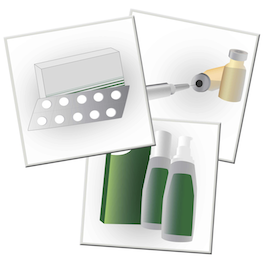There is an assortment of low testosterone treatment options for men with low testosterone. These options are known as testosterone replacement therapy, or TRT. Potential types of testosterone include transdermal gels, oral lozenges, implantable pellets, and injectable testosterone. Several factors can be used to determine the best available replacement option for each individual. These factors include cost, insurance coverage, convenience, ease of administration, and potential negative side effects. Before beginning TRT, it is important for a man to take the time to discuss the issue with his physician and determine the best possible administration method for him. (For more information on TRT, see EMG’s Testosterone Replacement Therapy Introduction).
Types of Testosterone: Low Testosterone Treatment Options
Below are links to fully explore the different types of testosterone, including the pros and cons of each. A summary guide of each of the low testosterone treatment options is also shown below based on the ease of use, regularity of application and potential for side effects.
Testosterone gels deliver testosterone through daily skin applications. On the positive side, gels mimic the physiologic release of testosterone in the body and can easily be applied. Also, T levels reach a steady-state in the first 24 hours of application and remain in the normal range for the duration of the application. Additionally, dosages can be easily modified. On the downside, gels must be applied every day and can potentially cause adverse skin reactions.
Testosterone injections deliver testosterone deep into the muscle. The testosterone is then absorbed into the blood stream over an extended period of time. The absorption period depends on the type of testosterone injected. On the positive side, testosterone injections must only be administered every one to two weeks with testosterone enanthate or testosterone cypionate or every ten weeks for testosterone undecanoate. They also allow for flexible dosing. Dosages can be changed with each injection, if necessary, to achieve optimal concentrations. On the downside, testosterone injections do not mimic physiologic dosing. As a result, testosterone levels fluctuate in the period between injections. Testosterone injections are also more likely to cause an increased red blood cell count than other types of testosterone. Lastly, injections can cause injection site pain.
Testosterone implants deliver testosterone via small pellets. The pellets are implanted under the skin by a physician. Pellets last anywhere between three to six months. On the positive side, testosterone pellets provide relatively even concentrations of total testosterone levels in the blood. They are also very convenient for men who do not want another daily medication requirement and/or travel frequently. On the downside, the implantation procedure is invasive and requires a physician who is trained in the procedure. Also, infection and/or pellet extrusion may occur. Lastly, it is difficult to adjust the testosterone dose once the pellet has been implanted.
Transbuccal (oral absorbable) forms of testosterone work by absorption through the mucous membranes of the mouth. A lozenge containing testosterone is placed under the tongue or against the surface of your gums twice daily. On the positive side, lozenges do not adversely effect the liver like orally ingested testosterone. Additionally, dosages can be easily modified. On the downside, lozenges must be kept in the mouth for a long period of time (up to 12 hours) and replaced twice daily. Also, they may cause gum irritation.
No forms are FDA approved in the United States. Outside of the US, testosterone undecanoate is the only safe form to use because it does not damage the liver like other oral forms.
Additional Notes on Low Testosterone Treatment Options
Of note, the two most common low testosterone treatment options are transdermal and injectable forms. Injectable forms have been around for many decades. The two most common forms (testosterone cypionate and enanthate) are both generic medications in the United States. Injectable forms are very inexpensive if self-administered. As opposed to injectable forms, transdermal forms are relatively new. Most forms are only available under a brand name. Brand names include Androgel, Axiron, Bio-T-Gel, Fortesta, and Testim. Transdermal gels are typically more expensive. Nonetheless, this form is now the standard type of testosterone for TRT.
There are currently no oral low testosterone treatment options that you physically swallow approved by the FDA for use in the US. (Note: Oral pills that are swallowed differ from oral lozenges which are not swallowed). Most oral forms available on the underground market may cause liver damage and should be avoided entirely. Overall, in the US, oral agents have no place in TRT in men.
Types of Testosterone Summary Guide
The following table provides the ease of use, regularity of application needed, and the potential for side effects by types of testosterone. (Click on the links to explore each low testosterone treatment further.)
Types of Testosterone |
Ease of Use |
Regularity of Application |
Potential for Negative Side Effects |
| Testosterone Gel | Easy | High - Daily | Low - Mimics Physiologic Doses |
| Testosterone Injections | Moderate | Low - Once every 2-4 weeks | Low to Moderate |
| Testosterone Implants | Moderate | Very Low - Once Every 2-3 Months | Low to Moderate |
| Testosterone Lozenges | Moderate | Very High - Twice Daily | Low |
| Oral Testosterone | Easy | High - Daily | High |
External Resources: Medscape: Types of Testosterone: Low Testosterone Treatment Options
Updated: April 26, 2015





